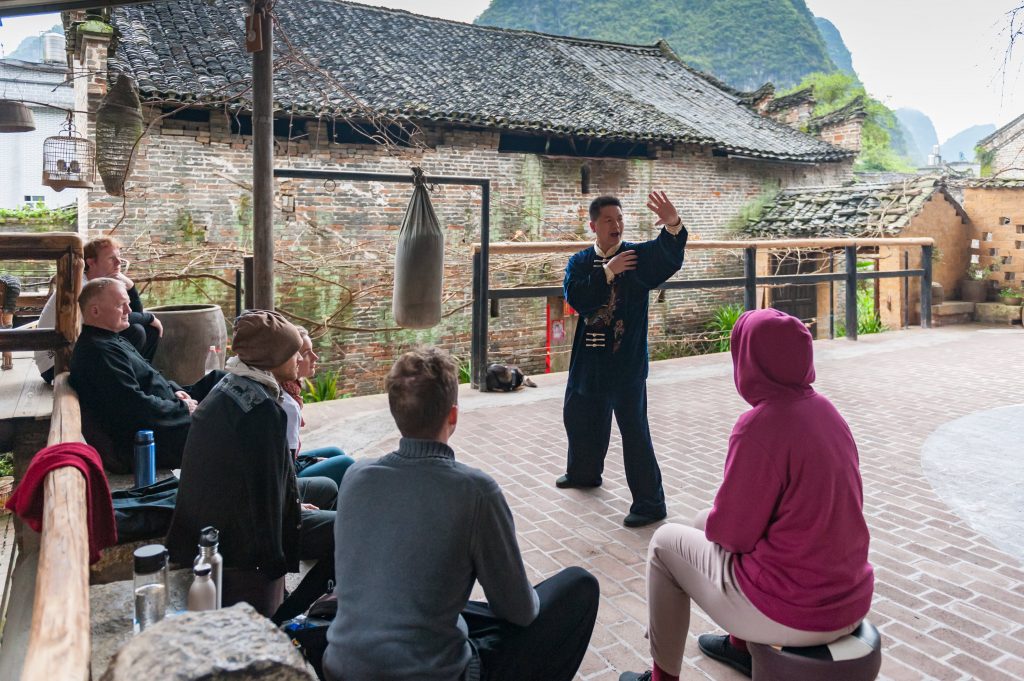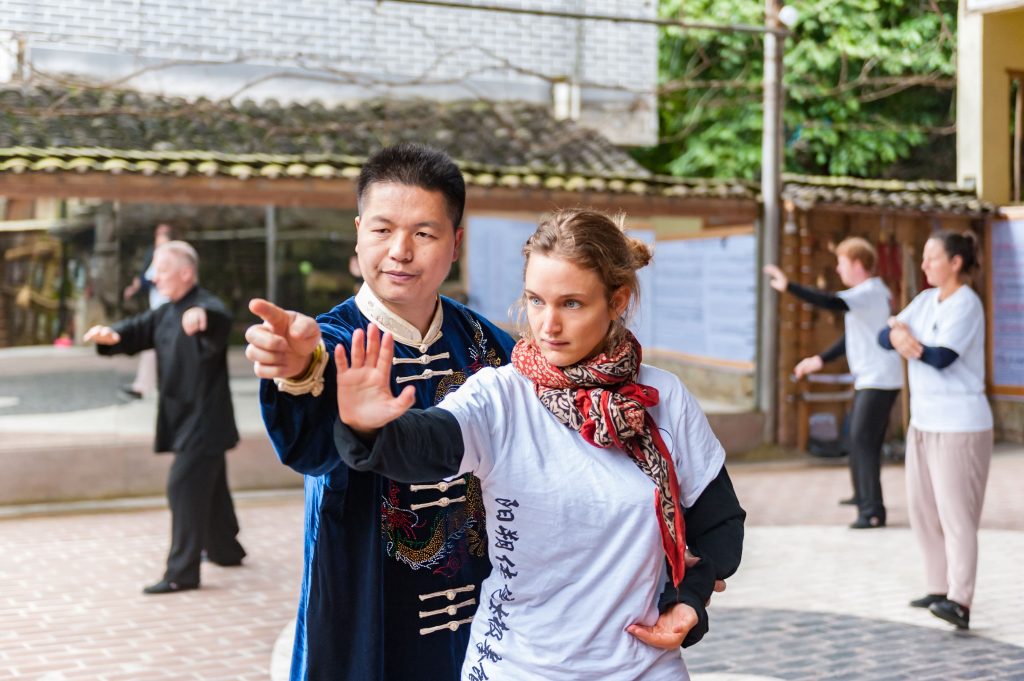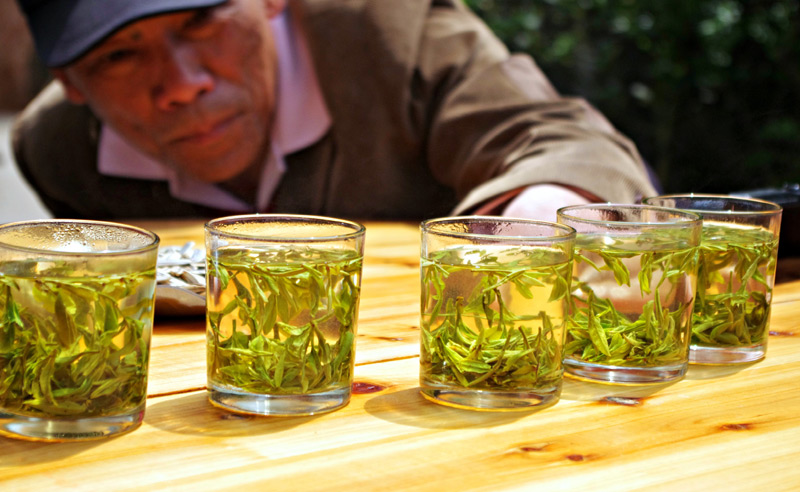Author Archives: Kim
The Practise of Tai Chi
1. In Tai Chi, tranquility means having a relaxed mind and is furthered by imagining that your body is merging into nature or your surroundings,becoming a part of the environment.
2. In Tai Chi, relaxation means that you are calm, relaxing your body by breathing. The pace and length of your breathing directly influences your body relaxation.
3. Sinking, normally used together with relaxing, is one of the special qualities that distinguishes Chen-style Tai Chi from the other styles of Tai Chi.It means that you allow your body, and Qi, to sink downwards into your feet.Chen-style requires the practitioners to focus their minds and their breath down to their Dantien which is a point about three inches below the navel.Advanced practitioners also then focus their mind and breathing down through the Dantien and then into the Bubbling Well, a meridian point in the middle of the foot. This takes some time to achieve and it requires patience. Even someone who has been practicing for six years may still have only a superficial understanding of intention in Tai Chi practice. Most of the movements in Tai Chi and Qigong are relatively simple, especiall yin Qigong. Even a beginner will gain the benefits of relaxation in their practice.However, to integrate breathing and movement together takes much more time. Your breathing pattern, including pace and depth, greatly influences your ability to relax. Correct Tai Chi breathing can regulate the nervous system, massage the internal organs, cultivate and regulate Qi and blood, promote a healthy metabolism and improve other functions as well. In Tai Chi practice, you use your mind and concentration to direct the Qi to circulate in your body. After consistent practice, you can feel Qi in your hand since the form of sensations of heat, numbness, tingling or an ache. This is a natural result of the increase of Qi and blood flow when body is relaxed. The “Reverse Abdominal Breathing” used in Tai Chi and Qigong is the opposite of the human body’s natural breathing. When inhaling, the lower abdomen is pulled inwards instead of naturally extending. Simultaneously the diaphragm rises and the Qi rises from the Dantien. As a result the chest naturally expands, increasing the lung capacity. When exhaling, the lower abdomen relaxes, the diaphragm drops, the Qi sinks into the Dantien and the stomach and chest return to the normal position. When a practitioner’s breathing has become deep, regular, slow and soft, they can begin practicing reverse abdominal breathing. Advanced practitioners who have mastered the basics of reverse abdominal breathing can then begin guiding Qi with their intention during their practice.The first stage of guiding Qi in this practice involves the Microcosmic Orbit, or small circle. When the practitioner inhales they also gently grip the ground with their toes, gently pull up their perineum and also slightly tip their pelvis so that their coccyx moves forward. Simultaneously, the practitioner visualizes Qi moving up the spine from the perineum to the top of the head.As the practitioner exhales they relax their toes and perineum, and allow their pelvis to relax so that their lower back straightens and their coccyx moves back a little. They simultaneously visualize the Qi moving from the top of their head down their front to their perineum. More advanced practitioners move onto practicing the Macrocosmic Orbit, or large circle, while they are reverse abdominal breathing. The process is the same as the Microcosmic Orbit, except that the circle of Qi being visualized is bigger. In the case of Macrocosmic breathing, the circle of Qi goes from the middle of the bottom of the feet up the legs, then up the spine to the top of the head during inhalation. Then during the exhalation the Qi is visualized as moving from the top of the head down the front of the torso, through the Dantien and then down the legs to the middle of the bottom of the feet.When practicing either the Microcosmic Orbit or the Macrocosmic Orbit, the tongue is always placed at the top of the mouth, touching the flesh just above the back of the teeth. The reason for this is that when we pull up the perineum and place the tongue on the flesh behind the top teeth, we connect two meridians to make a circle. This circle of Qi made by connecting these two meridian lines between the perineum and the top of the head is known as the Governing Vessel. Connecting these two meridian lines enables us toincrease our blood flow and to cultivate more Qi. Tai Chi and Qigong work with the principles of nature. Relaxation is the most important element of practice, at every stage.Tai Chi is a combination of philosophies, which includes the wisdom of meridian theory of Chinese medicine, Confucianism, Buddhism and the essence of the Taoism. It is a martial art created on the basis of Yin and Yang. Tai Chi cultivates sensitivity, relaxation, balance, rooting and speed, requiring intention rather than force. This is because when the mind is gently but clearly focused and the whole body is relaxed, our body parts can work together in unity. Then Qi flows smoothly, and the body is capable of great speed and strength. Power in Tai Chi is applied through softness in order to maintain speed,sensitivity and rooting. During striking, the body only tightens for a moment,during impact, before returning to a relaxed state. As the Tai Chi principle states, “Soft not weak, fast not stiff.” There are two main types of power in Tai Chi, soft power and strong power.Soft power can be applied quickly or slowly, but it is not applied through striking. Strong power is always applied with speed and striking, even if the two opponent’s bodies are already touching when the strong power is used.For example, you can strike with your shoulder to your opponent’s shoulder even when they are touching.Mechanical power in Chen-style Tai Chi is generated through a spiralling /rotating motion within the body. A high level practitioner will rotate their legs,pelvis, hips, spine and arms everytime they move.It is a flexible and elastic force, an explosive force produced by the spiral motion of internal energy and external strength.
Therefore, it appears soft in motion and powerful when it reaches its intended force. The Tai Chi Principle that all movement is formed by Intention is probably the least understood and most difficult principle to understand. Use intention/mind not force means keeping a quiet mind,focusing on breathing and reaching a still and silent mental state rather than learn movement without intention. Beginners find it easy to use rigid force. In this case, you have to relax, do not exert, try to feel that your body including the skin, the hair, the channels are breathing, extending or flowing Force comes from the coordination of Chi and exertion. Tai chi is circular,when a movement reaches its limit, the intention continues; when its intention stops, its form remains; when its form ends, its Chi/Qi moves on. During practice, when a movement stops, the exertion seems to break,however, the intention remains. Chi returns to DanTian, preparing for the next movement. When Chi comes back to Dan Tian, there is a swelling feeling,which connects with MingMen. When Chi is concentrated, stored and swelling in DanTian, movement can be quickly exerted. It seems that exertion breaks, yet Chi, under the instruction of intention, flows through the whole body,preparing for the next exertion at will. Follow the intention not Chi which may become a hindrance. Intention/mind ismore like inspiration, or put it this way: intention is an abstract will inspired and felt by heart. If intention is not felt or inspired by heart and it is felt with out the fullness of Chi, the exertion will become very mechanical and rigid. The mere pursuit of the feeling may also make a hindrance which blocks the intention or mind. In all, the principle of intention is a too abstract an idea to be understood and mastered. Moreover, there are different requirements for intention at different levels, which can be divided as follow: In the initial stage, the practitioner’s intention is mainly to remove the distractions by practicing Wu Ji meditation and simple basic movements,thinking, remembering the key movement, the structure of the Tao Lu (aseries of skills and tricks in Martial Arts), the execution of the form and so on.Teachers should be good at guiding students, from the simple to the deep,from the easy to the difficult. At this stage the instructor should avoid introducing any abstract concept such as “keep intention to Dantian” “use intention not force” and so on. It is difficult for the students to understand and accept these ideas, and they are easy to be misunderstood. In the second stage when the practitioners are familiar with Tao Lu (a series of skills and tricks in Martial Arts) after a period of practice and their movements are becoming more standard, they will feel in their hands sensations of numbness, heat, swelling, which means there is an awareness of developing the inner energy or Qi. At this point, the instructor can teach the concept of intention. Students will have a rough feeling about what intention is, and they can feel it in their hands. They should be instructed to keep the feeling, relax and coordinate their body so as the internal energy of Chi fill sand flows around the body The third stage comes after a long period of exercise. In this phase,practitioners feel that the internal energy of Qi fills into DanTian at the end ofeach movement, which is done by the power of the mind. When Qi fills DanTian, practitioners feel heavy and full at DanTian In the fourth stage, practitioners can use intention to lead the energy of Qi to their feet and then to the tips of toes. To this extent, practitioners feel flexible in movements, steady as a mountain when staying in stances. As intention moves smoothly and breathing is coordinated, energy of Qi can be felt flowing all around the body. Tai Chi is the transformation and change of Yin and Yang in the various forms such as Emptiness or Fullness, Opening or Closing, Fast or Slow,dynamic or still, soft or firm. They describe the various aspects of Tai Chi. For example, Emptiness and fullness represents the nature of Tai Chi, opening and closing represents the function of Tai Chi, dynamics represents the state of tai chi, fast and slow represents the rhythm of tai chi, reverse and obverse represent the direction of tai chi, softness and firmness represents the strain of Tai Chi. The overall generalization is: the whole body relaxed, experience the overall loose, moving the center of gravity and turning waist, master the entanglement of strength, the combination of the intention, Qi and breathing. Staring for long periods harms the blood; lying down too much hinders the internal energy of Qi; Sitting too long hurts the muscle; standing too long harms the bones; walking too much impairs the sinews. References for internal use only
Tai Chi in Yangshuo
I was in my early 60’s when the opportunity to learn Tai Chi came my way. I really had no idea what learning it would entail or the amazing benefits. I considered myself to be reasonably fit, but I soon found out there was another type of fitness.
Tai Chi involves quite slow movements. “How hard can that be,” I thought! For me, it was a challenge, but with a wonderful kind patient teacher, I gradually got the hang of it. But it was always a challenge for me to remember all the moves by myself.
My Master was Whu Heng Dong, (Kim) and I feel so privileged to have had the opportunity to be his student and now he’s a very good friend.
www.yangshuotaichi.com
One on-going comment was always about how good this was for my health. This became quite apparent to me as I continued to have classes many times a week. My flexibility and balance improved a lot. For mature age people, this is very important.
At that time Kim did not have his own school, but it was always his dream. He usually held lessons in Yangshuo Park which was always very pleasant, but no good during rainy times. He now has his own school in Yangshuo countryside so no more weather problems. His school is built in old traditional ways which is very fitting with an ancient art like Tai Chi.
Yangshuo provides a wonderful, memorable environment to learn Tai Chi in. If that interests you, contact Kim and make plans. You will not be disappointed. Kim has fluent English and teaches in English.
Martial Arts Etiquettes - the “Palm Hold Fist” Salute
In traditional Chinese culture “Learning courtesy comes before learning the art, and learning morality comes before learning the martial arts”, so the first lesson of learning Tai Chi and Qigong is not to learn the movement directly, but to learn Martial Arts etiquette.

The “Palm hold fist” salute is the most commonly used for the rituals of the martial artist. It originates in the traditional etiquette of the Chinese Han people, going back to the Zhou Dynasty more than 3,000 years ago.
How to salute:
One hand holds the fist and the other hand clenches the fist. Both of them
are closed in front of the chest. The fists are closed with four fingers and the thumb is slightly bent.
There are two types of “palm hold fist” salutes for martial artist:
1. Palm on the left and fist on the right;
2. Fist on the left and palm on the right.
The difference:
1.Palm on the left and fist on the right: a martial artist’s fist is stronger than the palm, and so the fist is restrained by the palm to as a sign that its strength is not offensive; the left hand holds the right fist naturally and without stress. Bow slightly, cupping one hand in the other before one’s chest, shaking slightly, naturally, neither too strongly, nor too high. This is called the “propitious salute”.
2.Fist on the left and palm on the right (ie, hands reversed): this is called the “infelicitous salute”. It is mostly used for mourning. In any other circumstances it would be a sign of disrespect.
Meaning:
1.The left palm signifies civilization, morality, intelligence, and physical fitness. The thumb is slightly flexed to indicate that it is not arrogant
2.The right fist signifies the Martial art .
The left palm and the right fist together represent being endowed with both civilization and the Martial art, being eager to seek knowledge, and respectfully asking higher seniors or masters to teach it.
The use of this salute throughout the world of Martial Arts indicates the common culture of all Kung Fu and Tai Chi masters and practitioners.
With the development of modern society, the “palm hold fist” salute is no longer used outside the Martial Arts, and has been replaced by the handshake known in the West. The traditional “Wanfu salute” once used by women has also disappeared.
Nowadays, traditional etiquette will only be seen occasionally, on special occasions.
However, when you see others wearing different clothes and performing different “traditional salutes”, don’t take it for granted that you should imitate them. Try to understand the meaning behind the etiquette so as to avoid jokes, or giving offense.
Tai Chi Push Hands: An Exercise for All Practitioners
In solo forms, tai chi is a way to understand one’s self. It’s a way to feel the internal flow of energy, as well as any internal tension. There is no opponent except whatever negative thoughts, heavy emotions, or internal demons arise.
Tai Chi Push Hands: External Forces. With push hands, one must deal with external forces in addition to whatever internal stress one carries. Rather than feeling simply the air, one has a direct experience of the force and energy from one’s practice partner.
A Training for Martial Arts. Push hands is a version of sparring in tai chi. It is the bridge to move from a fluid solo form to tai chi for martial arts. Two persons maintain arm contact while trying to unbalance and to push each other.
But, push hands is not a sumo match and it’s not about sheer mass or muscle power. There’s typically no hitting, kicking, although there’re some push hands styles where throws and joint-locks are all part of the game.
Push Hands for All Practitioners. It’s also possible to practice push hands in a non-threatening and cooperative way. This form of push hands is useful for all tai chi students, even those without an interest in the martial aspects of tai chi.
Push Hands for Relaxation. The key is to use relaxation, intent, awareness, sensitivity, and knowledge of the internal energies to push and to uproot your partner. It tests your ability to root and to remain relaxed and balanced, despite whatever forces are coming in from the external environment.
When confronted with an opponent or even a practice partner, it’s easy for emotions such as fear or anger to arise. Pushing to win can also take you away from a relaxed state. Focus to maintain a steady breath and a relaxed stance with good alignments.
When you’re tense or not well aligned, it will be easy for your partner to take your balance. This forces you to quickly recognize and to relax areas of tension—or you will find yourself easily off-balanced by your partner.
Circles in Push Hands. Like all of tai chi, push hands involves circles. Here, the hands circle back and forth between the two practitioners. One half of the circle defends, and the second half attacks.
Yield and Defend. For defending, the emphasis is on rooting or grounding, and deflecting or yielding to an attack. There is no attempt to directly oppose the force from your partner.
Attack. Immediately after yielding, counter and attack by using your partner’s force against him or her. If your partner has overextended and is tilting forward, you’ll find that only an ounce of force will be needed to send them off-balance.
Tea and Tai Chi: a way of being-in-the-world
“The journey of a thousand miles begins with a single step (…or sip)” Lao Tzu.
The relationship of Tai Chi to Tea is, like anything to do with Chinese traditional culture a long and complex story. However we can take a first step in understanding this story with a very simple idea; Cǎi (採, cǎi) pronounced Tsai. One of the Eight Basic Methods of Chen Style Taijiquan[1], Cǎi means to pluck, taking its name from the short sharp twist used to pick the tips of the tea bush (採茶, cǎi chá). The move follows the flow of approaching force and without interruption diverts it into emptiness.
To give another example, Wave Hands Like Clouds (云手 Yún shǒu) is another very famous Tai Chi movement. To move hands like clouds is to move with a natural soft flowing movement but with intention. This doing without doing is one of the attitudes of thinking and doing that is inherent in Daoism. Tea drinking similarly embodies Daoist ideas in the way in which sharing tea is an opportunity to be mindful and truly present. They are interlinked through their spirit, they both seek to refresh one’s mind and body. So it seems that mindfulness and stillness can be practiced equally through the ritual of making and imbibing tea, as it can through the practice of Tai Chi forms. So from the start we can see an example of how Tai Chi, Tea and the principles of Daoism are all intricately interwoven.
Practising Tai Chi form reveals for us many aspects of Daoist spiritual culture and drinking tea offers us yet another way to integrate this feeling of being-in-the-world into our daily lives and way of looking at the world around us. Being-in-the-world is to be in the middle of the world, amongst things, immersed in the now. Kakuzo Okakura writes in the classic Book of Tea[2] (1906), “Chinese historians have always spoken of Daoism as the ‘art of being-in-the-world,’ for it deals with the present–ourselves. It is in us that God meets with Nature, and yesterday parts from to-morrow.”
Out of stillness we come into presence, being part of the world in harmony and balance with nature. A very Daoist concept, the ‘tea-mind‘, that is to say, “a way of being-in-the-world, a way of living a life of grace and gratitude, of being able to see the sacred in the seemingly mundane”. This is the heart of Daoism, and we are told, the way of tea (茶道chá dào). It is also the way of Tai Chi.
Drinking tea has been a Chinese custom for thousands of years, with the earliest records dating back to the 10th-century BC. Chinese philosopher Laozi described tea as the “froth of the liquid jade“, and called it an indispensable ingredient in the elixir of life by which he means it is an important contribution to our longevity and health. In his book Cha Dao: The Way of Tea, Tea as a Way of Life, Solala Towler writes, “Daoists follow nature… and so Daoists like tea because it comes from nature. Tea is the flavour of the Dao”.
Indeed the health benefits of Tai Chi and tea are complimentary as many scientific studies have shown. Dr. Greenwood[3], an expert on the relationship between diet, nutrition and brain health, tells us that “the compounds in tea appear to impact virtually every cell in the body in a positive health outcome, which is why the consensus emerging from this symposium is that drinking at least a cup of clear green, black, white or oolong tea a day can contribute significantly to the promotion of public health”. So drinking tea has a whole body benefit just like Tai Chi.
Meanwhile, researchers at Texas Tech University Health Sciences Centre have established that a combination of Tai Chi exercise and green tea can contribute to improved bone health and muscle strength. So in combination Tai Chi and tea means healthy bones, improved balance, clarity of thought, and a boost to the immune system.
Aside from individual benefits Tai Chi is often performed with others and and brings with it benefits of social inclusion. Being part of group, meeting and practicing with others it’s essence is social harmonising the individual in the social. Tea too, brings people together and reflects the individuals relationships within the world.
Tea and Tai Chi is being-in-the-world, being part of the world, being in harmony with the world, being in nature.
Author :
Tai Chi-thailand
Tai Chi-thailand
Tai Chi improves memory
Tai Chi makes your brain bigger and can improve memory and thinking – possibly delaying the onset of Alzheimer’s disease, claim scientists. – The Telegraph –
A new study has revealed how elderly people practising Tai Chi – an ancient Chinese form of slow, meditative exercise – just three times a week can boost brain volume and improve memory and thinking.
As the exercise increases mental activity, scientists believe it may be possible to delay the onset of incurable Alzheimer’s in pensioners.
Dementia and the gradual cognitive deterioration that precedes it is associated with increasing shrinkage of the brain, as nerve cells and their connections are gradually lost.
Previous research has shown Tai Chi can help relieve stress, improve balance in the elderly and stave of high blood pressure – helping those who suffer from heart disease.
Although scientists know brain volume can be increased in people who participate in aerobic exercise, this is the first study to show a less physical form of working out, like Tai Chi, can have the same results.
Researchers conducted an eight month controlled trial on Chinese seniors, comparing those who practiced Tai Chi three times a week to a group with no intervention.
Participants also had lively discussions three times a week over the same time period, with results showing a similar increase in brain volume and improvements on memory and thinking as those exercising.
Findings also revealed the group who did not participate in Tai Chi showed brain shrinkage over the eight months – consistent with what generally has been observed for elderly people in their 60s and 70s.
The research suggests forms of exercise like Tai Chi, that include an important mental health exercise component, are associated with increased production of brain growth factors like aerobic exercise.
Dr James Mortimer, of the University of South Florida, said: “If this is shown, then it would provide strong support to the concept of ‘use it or lose it’ and encourage seniors to stay actively involved both intellectually and physically.
“The ability to reverse this trend with physical exercise and increased mental activity implies that it may be possible to delay the onset of dementia in older persons through interventions that have many physical and mental health benefits.
“Epidemiologic studies have shown repeatedly that individuals who engage in more physical exercise or are more socially active have a lower risk of Alzheimer’s disease.
“The current findings suggest that this may be a result of growth and preservation of critical regions of the brain affected by this illness.”
The study, helped by Fudan University, China, was published in the Journal of Alzheimer’s Disease.
A Teacher for a day is a parent for a lifetime..
Tai Chi Theory
Tai Chi Theory
TAI CHI
Tai Chi movements are slow soft and graceful with smooth and even transitions between them, The meditative nature of the exercises is calming and relaxing.
Tai Chi Chuan or (taiji quan) exercise helps blood to move around inside the body. This is very important blood takes food to all parts of our bodies ,the brains in our heads also need blood. If we keep our bodies healthy and do exercises, we can think better.
TAI CHI & HEALTH
When practising Tai Chi, the practitioners consciousness, breathing and actions are all closely connected. The transfer and focus of the practitioners energy corresponds to the network of maridians joining the acupuncture points used in traditional Chinese medicine. Tai Chi exercises stimulate blood circulation and the inner organs, as well as improving strength and muscle control.
Tai Chi exercises help to improve health, co-ordination and posture and will promote general fitness and weight loss. Tai Chi stimulates the body and calms the mind, resulting in a balanced outlook and an overall improved sense of well being.
TAI CHI PUSH HANDS
Push-hands is a practice method of traditional Tai Chi martial arts. Two students with their arms in contact practice twining and sticking actions to develop the sense of touch, awareness and balance within the body.
This is the training method where Tai Chi movements connect with martial arts applications, and develops the understanding of how small forces can defeat strong physical power.



















